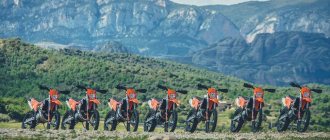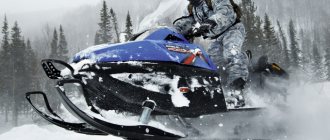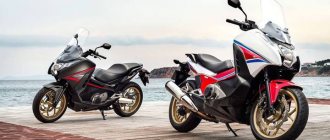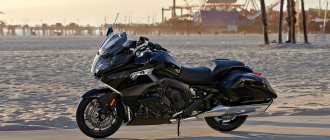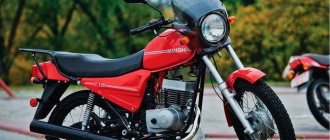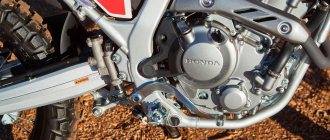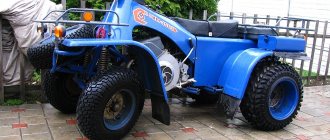Gibbs Technologies began operations in 1996, having moved from New Zealand to the USA and then to the UK. Today it is the most influential company in the world in the development and production of high-speed amphibians. This is the sole owner of the HSA (High Speed Amphibian) technology, thanks to which the unique Gibbs Quadski amphibious ATVs are produced today. The first model was developed in 2008, and it went into mass production in 2012. These are unique vehicles, the likes of which have never existed before.
Advantages of water ATVs:
- The device combines all the best qualities of an ATV, aquabike and a jet ski.
- The maximum speed of the vehicle is 72 km/h on land and water.
- Transformation from an ATV to a jet ski takes 5-7 seconds. at the press of just one button. At the same time, the wheels rise up, providing high-quality gliding along the water surface.
- The powerful, liquid-cooled, four-stroke, four-cylinder, motorcycle-type engine of the BMW Motorrad K1300 features a jet ski-like jet.
- Light metal is used in production, which provides a fairly large floating ATV with maneuverability and good controllability.
- The design is completely sealed, which allows you to do dives and other tricks on the water. The ATV is also not afraid of rollovers, which makes it no less functional than a jet ski.
- There is a built-in protection system that uses sensors to determine whether the ATV is on water or land. The system also has a built-in throttle position and speed sensor.
- The design and all systems are thought out to the smallest detail. If the ATV is traveling over rough terrain and a large boulder hits its bottom, the bottom will not break through. A special plastic patented by the company, which is both durable and elastic, is responsible for this.
- Liquid from the tank is supplied under pressure, cleaning important systems from dirt.
Today, all extreme riding enthusiasts know about ATVs for water and off-road use. The first Gibbs Quadski development broke the record for amphibians, managing to cross the English Channel in 2 hours.
Hybrid of ATV and jet ski
In 1996, Gibbs Technologies began its work, whose unique developments made it possible to create a hybrid of an ATV and a high-speed jet ski. Today there are no analogues to this type of transport in the world. The predecessors of the water ATV cannot boast of such dynamism, speed and attention to detail. The manufacturer has developed a unique HSA (High Speed Amphibian) technology. On its basis, in 2008, the Gibbs Quadski amphibious ATV model was created, mass production of which began in 2012. The resulting ATV and jet ski in one includes a number of unique developments.
The advantages of a floating all-terrain vehicle are the following facts:
- High speed of movement both on land and water (which was previously impossible to achieve), which reaches 72 km/h.
- Combines all the best characteristics of a jet ski, aquabike and ATV.
- Almost instantaneous transformation from a land vehicle to a personal watercraft. The transformation takes only 5-7 seconds. To transform, you only need to press one button. The wheels will rise up, taking a horizontal position in special compartments. This ensures high-quality gliding through the water.
- Unique BMW Motorrad K1300 engine, equipped with liquid cooling and a built-in jet ski nozzle, just like on a jet ski.
- The ATV, floating on water, has large dimensions, but at the same time remains maneuverable thanks to a body made of special plastic and light metal. This vehicle is characterized by good handling.
- Sealed design ensures high safety even if the ATV overturns. Moreover, the car received the same capabilities as a jet ski. This allows you to perform various tricks on the water and even dive.
- The built-in intelligent safety system detects whether the ATV is on water or on land. Therefore, you cannot accidentally switch the mode, as the lock will work. Speed sensors and throttle position detection are also provided.
- The developers thought through the system down to the smallest detail. For example, the use of special plastic, patented by the company, makes it possible to avoid the bottom from breaking when hit by a stone accidentally flying out from under the wheels of an amphibious all-terrain vehicle. This became possible thanks to the high strength and at the same time elasticity of this unique material.
- The system contains a special fluid that is supplied under pressure and cleans important components of the mechanism from dirt.
There are no analogues to an amphibious ATV in the world today, since other modifications, for example, an amphibious jeep, an amphibious vehicle, cannot boast such a high speed. The Gibbs Quadski has broken the amphibious record by swimming across the English Channel in just 2 hours.
Watch the video
It took mankind many decades to create an amphibian, which is a full-fledged car on land, and an equally full-fledged boat on water. Few people have not heard about the famous Aquada, which at one time became a real sensation. A jet ski and an ATV, it would seem, are a little simpler than a sports car and a speed boat, and indeed almost “relatives”. However, if an ATV, at the very least, can still be classified as a purely transport vehicle, then a jet ski is primarily a sports equipment. So the task assigned to the Gibbs Sport Amphibians engineers was clearly more difficult than in the case of the “planing car.” However, it was resolved, and I can personally testify that it was resolved brilliantly.
However, the car that I approached, twirling the “marine” keychain-float with the ignition key on my finger, resembled a familiar quad only in the presence of four “toothed” wheels, high ground clearance and a motorcycle-type steering wheel and seat. The bright yellow “body” (such a concept is not particularly applicable to ATVs) is more reminiscent of automobile associations. More like a buggy, although sit it lower, put it on wide slicks, and in place of a motorcycle seat, cut out an oval cockpit with a wind visor - and here you have a classic road spider, the child of asphalt highways and parking lots in front of trendy restaurants. Most of all, the Quadski resembles a sports car from the rear angle - the rather massive rear with a pair of round red lights looks painfully impressive (by the way, the “dimensions” and “stops” work properly).
I sit comfortably on a wide seat, placing my bare feet on long footrests covered with sides. They say that thanks to such “baths” you can slide into the water without getting your feet wet, but I... hmm... have a slightly different task. I attach a safety strap with a wide, durable bracelet to my left hand, turn the key, press the starter button (red, of course) - and the four-cylinder BMW Motorrad K1300 immediately responds with a bass rumble. When setting up the muffler, the goal was clearly not to scare the public - the car already has something to surprise others.
By the way, the power of the iconic motorcycle engine is slightly “stifled” - up to 140 hp. With. against the original 175. Considering that hydraulics usually follow the principle of “gas to full and all speeds at once,” this is quite logical, at least from the point of view of increasing the resource of an already heavily loaded motor. In addition, when switching to “water” mode, that is, to a water jet, the electronic “brains” begin to prepare a richer mixture, stretching the torque over a wider rpm range.
The clutch is automatic, so before starting, I held the brake lever on the left handlebar just in case. At idle, the Quadski does not tend to move forward, like many cars with an automatic transmission, but you have to keep your eyes open: the slightest press of the gas trigger causes a noticeable jerk forward, so to move “whispering” I had to remember the old trick of sticking my index finger under the trigger as a limiter.
Like any quad, the Quadski is not intended for driving on public roads, so I didn’t risk driving out into Dmitrovka, which was clogged with cars, limiting myself to riding on the club’s paths. By the way, the speed on land is forcibly limited to 72 km/h, and to achieve it you need to manually change gears using a button on the steering wheel. But the box can switch “down” automatically. With a rear-wheel drive design and a very lively engine, I was tempted to drift around some lamppost, but on the asphalt I felt sorry for the tires that were not suitable for this with powerful “soil-water grips”, but about doing this on the well-groomed lawn next door with a cage of peacocks, there was no question. When turning on narrow paths, I had to resort to the green reverse button a couple of times - here the Quadski completely turns into an electric car, since in reverse the starter motor becomes traction (prolonged use of the button is not recommended).
In short, soon I decisively turned the steering wheel towards the slip. Needless to say, a sizeable crowd had already gathered there, armed with cameras and cell phones? A few seconds - and Quadski and I are already afloat. By the way, you can continue moving on water in the “land” version by adding gas: the transverse lugs of the tires work like the plates of a paddle wheel, as on many floating all-terrain vehicles. This can be useful when you are not sure that there is no shoal waiting for you beyond a deep area near the shore, or when you are afraid of any coastal debris being sucked into the water jet. However, there are no such problems at a yacht slip. Pressing a button, loud beeps - and a magical transformation took place: it was an ATV, it became a PWC. In exactly five seconds, the electric motors pulled the wheels under the “wings”, and the engine switched to a water cannon.
The responses to the trigger became calmer, and I crossed the harbor at a slow speed appropriate for the situation, in displacement mode. But after the weekend buoys the song began. Those who like to have fun on a hydrika to the fullest (and not just ride such a device in a straight line to the neighboring village for beer) will understand me. Already after the very first turns at full speed, I was overcome by a feeling of permissiveness. In fact, such a feeling can be fraught with trouble, but this unusual device behaved extremely safely, obediently and predictably! In principle, the sensations are almost the same as on a classic sit-on jet ski, except that the rolls are not so deep and the slides are a little more “extended”. Not surprising - the car is quite wide. Having turned on the spot at full speed, the Quadski immediately shoots forward again, practically without falling off the planing mode. And straight ahead, the GPS navigator I took with me showed exactly 72 km/h - the real figure coincided with the advertised one literally with pharmacist precision.
The wave also did not turn out to be a hindrance (naturally, any wake from large and small boats crossing the reservoir immediately went into action). The main thing is to press the trigger all the way and only occasionally get up from the seat, habitually absorbing the shocks with your legs. Having let off the gas on the wave, I immediately paid for it - a wall of spray that flew out from under the nose covered me completely (but we’ve already done this on other jet skis).
I don’t know how long I was hanging out like this, accumulating endorphins in huge doses, but only the fuel gauge needle, which dropped almost to zero, brought me back to reality. Having taxied into the canal ending in a slipway, I did not get close to the exit. Another press of the button, again the squeak of the beeper... As soon as it fell silent, it was replaced by the boiling water - the drive wheels came into action. It turns out that you can even steer along the course in this mode - the front wheels act as steering wheels. Having taken off along the slip, the Quadski obediently froze, rooted to the spot - being in the water had no effect on the efficiency of the disc brakes. "Adrenalin! Adrenalin!" - comes from the audience gathered around. “Oh, you,” I think to myself, smiling stupidly for some reason. – What does the fear hormone have to do with it? There are completely different hormones at play here, and in crazy quantities!”
SUMMARY
A toy, of course. Expensive, stylish, technically advanced toy. But you never know in the world of things, the owners of which, foaming at the mouth to prove their practical value, still understand in their souls: it’s not at all about the ability to carry cargo, storm off-road conditions and overcome water obstacles. It's about the process itself and the feelings it gives. Quadski is able to successfully and practically without compromise provide this process in two elements at once to choose from. Are we waiting for a flying version of the miracle machine?
| Gibbs Quadski | |
| Length, m | 3,2 |
| Width, m | 1,58 |
| Height, m | 1,4 |
| Dry weight, kg | 576 |
| Track, m | 1,4 |
| Wheelbase, mm | 1799 |
| Crossing angle, degrees: | |
| – front | 46 |
| – rear | 26 |
| Engine power, l. With. | 140 |
On the left handlebar there is a brake lever, a gear shift button (yellow), a reverse button (green) and a start/stop button (red, supplemented by an emergency ignition switch with a strap); on the right - only the gas trigger. To the right of the ignition switch there are buttons for turning on the “land” and “water” modes (in addition to the sound alarm, the corresponding symbol lights up on the instrument panel with the speedometer and fuel level indicator), on the left is the button for turning on the headlights and side lights
HOW IT ALL STARTED
Strictly speaking, the first amphibian, combining a full-fledged car and a full-fledged planing boat, was created in New Zealand back in 1992 - it was the experimental Sealander, built by engineer Terry Roycroft. New Zealand businessman Alan Gibbs liked the system with retractable wheels so much that he immediately bought a patent from the developer and started working. The first Aquada was tested on the Thames in 2003 - 170 km/h on land and 50 km/h on water. A year later, English entrepreneur Richard Branson successfully crossed the English Channel on an Aquada. Unfortunately, this car remained practically a “concept”, produced in a relatively small series. Judging by the efforts spent on Quadski certification (and this process, taking into account the participation of both land and water “offices” in it, took no less than seven years), the new product promises to become much more widespread.
№ 3 (85) 2014
Hybrid ATV and jet ski Quadski-1
The ATV, which was developed by Gibbs Technologies, is available in two modifications. They differ in size and passenger capacity. The lightweight version is Quadski-1, which is designed for one person. A larger all-terrain vehicle is the Quadski XL, designed for two passengers. The single-seat ATV-hydrocycle has the following technical characteristics:
- BMW engine, injection four-cylinder, four-stroke.
- Passenger capacity – 1 person.
- Power – 140 hp
- Engine capacity – 1293 cc. cm.
- Cooling is liquid.
- Brakes are hydraulic.
- Load capacity – 120 kg.
- Gas tank volume – 57 l.
- Control - trigger-type gas, one steering lever.
- Transmission – five-speed, electromechanical.
- A water cannon is a nozzle combined with a gasoline engine.
- Track width – 1.41 m.
- Length – 3.26 m.
- Width – 1.58 m.
- Height – 1.36 m.
- Ground clearance – 2.25 m.
- Wheelbase - 1.79 m.
- Weight – 605 kg.
The ATV consumes 6.3 liters of fuel (AI-92 gasoline) in the combined cycle, and when driving in the city or water, the figure increases to 7.5 liters per 100 km.
Quadski XL
The Quadski XL model is characterized by increased dimensions and can carry two passengers. The characteristics of this vehicle are as follows:
- BMW engine, four-stroke injection, four-cylinder.
- Passenger capacity – 2 people.
- Power – 140 hp
- Engine capacity – 1293 cc. cm.
- Cooling is liquid.
- Brakes are hydraulic.
- Load capacity – 185 kg.
- Gas tank capacity – 57 l.
- Control - trigger-type gas, one steering lever.
- Transmission – five-speed, electromechanical.
- A water cannon is a nozzle combined with a gasoline engine.
- Track width – 1.41 m.
- Length – 3.56 m.
- Width – 1.58 m.
- Height – 1.34 m.
- Ground clearance – 2.15 m.
- Wheelbase - 2.09 m.
- Weight – 652 kg.
Features of walking on land
Both Quadski modifications have independent suspension, and torque is transmitted to each wheel. The control system has a button, by pressing which you can disable the front axle, making the vehicle rear-wheel drive. Differentials are available on both axles, which allows you to move this ATV even on asphalt.
Gasoline consumption when driving on land is quite low, which allows you to travel about 600 km on one full refueling. The gas trigger of this model is located on the right under the driver's thumb. This is typical for ATVs. On jet skis it is located under the index finger.
Gibbs Quadski amphibious ATVs and their operation
Quadski ATVs are equipped with independent suspension, and torque is transmitted to all 4 wheels. If desired, by pressing a button, the front axle can be turned off. Both axles have differentials, so this vehicle can even be driven on asphalt.
The motor is quite economical when driving on land. A full gas tank of the ATV is enough for about 600 km over rough terrain. The versatility of the vehicle opens up great prospects for its use in rescue or military operations, and not just for leisure.
The throttle trigger is located, as on all land ATVs, under the thumb on the right. On jet skis it is located under the index finger. The ATV accelerates quickly, which is immediately reported by the howling gearbox. To control it, when the speed increases, you need to switch the key manually (located on the left). When the speed decreases, the reset to lower stages occurs automatically.
On land, engine power is limited to 45 hp. With. This is enough to easily accelerate to a top speed of 72 km/h. The ATV enters a fast turn with confidence, but you need to hang down to stay in the saddle. If you ride relatively slowly, you can sit in the saddle.
To perform the reverse function, the system has a separate electric motor. It works exclusively in reverse, allowing you to drive backwards within 10 seconds. The system then turns off, requiring recharging from the standard battery.
Riding on water
A unique vehicle develops high speed when crossing the water surface. In this mode, fuel consumption increases sharply, which is why the gas tank is completely used up in just a couple of hours. Intelligent control of the ATV system when driving on water includes a special mechanism for preparing the fuel mixture. This contributes to the proper operation of the water cannon, which requires significant energy costs. But thanks to this feature, maximum power is achieved already at 7000 rpm.
Catalog
This hydro ATV is capable of not only overcoming water obstacles, but also giving riders incredible pleasure. The amphibian accelerates through water at a speed of 72 km/h! Quite a normal speed to get a dose of adrenaline by dashing into turns on the water surface. On the ground, the Quadski also reaches speeds of up to 72 km/h. The main highlight of the Quadski is that when you press a “specially trained button,” the wheels of this amphibious amphibian fold, driving inside the wheel arches, and do not interfere at all with gliding across the expanses of water. The procedure for turning an all-terrain vehicle into a jet ski (and back) takes about 5 seconds. The 140-horsepower 4-cylinder liquid-cooled gasoline engine has a water jet (exactly like on a jet ski), which comes into operation after pressing the button that folds the wheels. Quadski is completely sealed and is not afraid of flips on the water, so you can do tricks and all kinds of dives no worse than on a regular aquabike. The Quadski amphibian is foolproof. Installed sensors (speed, throttle position and a sensor that tracks where the Quadski is: on land or in water) eliminate the possibility of doing anything stupid and releasing the chassis on the water or, on the contrary, removing them on the road, which means breaking this technically complex device. The Quadski amphibian is thought out to the smallest detail. If you are driving across a field and do not notice a cobblestone lying in your way, the bottom of the amphibian will not burst, because the special patented plastic composition has good strength and at the same time elasticity. Half a minute ago you were kneading mud, and now you decided to swim. Clods of earth stuck to the suction hole of the pump can instantly destroy, if not the engine, then the water cannon itself. To avoid any accident, the Quadski has a water tank. Liquid from the reservoir under pressure clears dirt from the channels vital to the pump. A little about the Quadski's overland characteristics.
The 4-cylinder power unit with a displacement of 1.6 liters produces 140 “horses” already at 3500 rpm. At the same time, the engine on land is quite economical: a 50-liter tank is enough for 600 kilometers of cross-country driving. Fuel consumption on water is not so gentle - a full tank lasts for a couple of hours. When the water jet is turned on, the “brains” that control the operation of the injection engine begin to prepare a different fuel mixture. As a result, the engine produces maximum power already at 7000 rpm. The Quadski's suspension is completely independent. The levers are made of forged aluminum (as is the supporting frame), making the amphibian very light (583 kg). In the civilian version of the Quadski, torque can be transmitted to all four wheels (by pressing a button you can connect or, on the contrary, disconnect the front axle), while both axles have differentials, so this amazing amphibian can even be driven on asphalt. The Quadski version for rescuers and the military is somewhat different, because the rear axle does not have a differential. But for extreme off-road driving on the military version of the Quadski, you can lock the center differential and the front axle differential. Yes, it’s difficult to steer, but at least you can get to the end of the world. The Quadski is a practical and incredibly exciting vehicle, says founder and owner of Gibbs Technologies Ltd. A native of New Zealand, Alan Gibbs. “Our Quadski can be a great leisure vehicle, but it can also be useful for rescuers and the military, for whom the versatility of a vehicle is always a plus.
*It is possible to order the ATV in any color, delivery time is 3-5 days. Or pasting with high-quality car film. Available in Red Apple color (as of 09/10/2014)
Amphibious Quadski: a hybrid of an ATV and a jet ski
Inventors have long sought to create universal things. But successful solutions are still rare, and the saying “universal is the enemy of the good” is usually true. It is clear that in some cases universality cannot be avoided. For example, an army cannot do without amphibious vehicles. But it usually turns out that the car feels confident in one environment, but barely moves in another. For example, hovercraft develop high speed on water, but on land their task is simply to get ashore or overcome a small piece of land. With amphibians the situation is the opposite: they move well on land, but on water they swim slowly - they crossed a river and did well. Inventor Alan Gibbs proposed the design of a very interesting amphibious roadster, the Gibbs Aquada. Many body features were clearly similar to the Mazda MX-5, but there were still no accusations of plagiarism. The car accelerated on land to 160, and on water - up to 60 km/h. In 2004, it even set a record for crossing the English Channel for amphibians. However, the car did not go into production. The reason is the very high price. It was planned to sell the product for $150,000, and marketers approached this project with caution. Which, you see, is quite understandable.
Length: 3200 mm // Width: 1600 mm // Height: 1400 mm // Weight: 535 kg // Engine: 4-cylinder, 16-valve // Power: on water 140 hp, on land 45 hp. With. // Load capacity: 120 kg // Ground clearance: 230 mm.
Alan Gibs did not lose heart and proposed a different amphibian. If before he crossed a car and a boat, now he decided to combine an ATV and a jet ski. The idea turned out to be brilliant. The first copies of Gibbs Quadski appeared in 2008, and mass production has been underway since 2012. Last year, more than 1,200 copies rolled off the American assembly line in Michigan, and now, despite the global crisis, production is not keeping up with demand. So this year it is planned to produce at least 5,000 copies.
First test of the Gibbs Quadski
A surprisingly well-handled, agile on the water, but impractical amphibian.
It is very difficult to imagine anyone who would turn down the opportunity to ride a Gibbs Quadski. After all, it is a hybrid of an ATV and a jet ski! This is an all-terrain vehicle that, at the press of one button, allows the owner to feel like a child and a movie hero. With the help of unknown forces, you will move from land to sea, dealing with imaginary Decepticons and riding off into the sunset with Megan Fox. Okay, it's not as cool as fighting robots from outer space, and the single seat design will force you to leave Miss Fox on the shore, but driving a Quadski is a unique and unforgettable experience.
Powered by a BMW K1300 motorcycle engine with an impressive 175 horsepower and 140 Newton meters of torque, the 600-kilogram Quadski accelerates to a top speed of 72 kilometers per hour. Power is sent to the rear wheels through a six-speed automated manual transmission controlled by steering wheel buttons. The BMW engine is undoubtedly capable of developing more
faster, and we expected more from BMW in the world of ATVs and all-terrain vehicles, but Gibbs' decision to keep the amphibian's top speed under 50 mph is understandable. The machine is heavy, the composite hull is relatively fragile, and a malfunction could lead to a big problem on the water.
The machine's low center of gravity and 1,471mm width make it surprisingly comfortable and capable on ATV trails, but the lack of all-wheel drive gives it some serious consideration. Most two-wheel drive ATVs have trouble in the soft, slippery mud found on most shorelines, so the Gibbs Quadski needs to generate quite a bit of speed when moving in and out of the water.
The Quadski body is strong, reliable, lightweight and made from a single piece using modern composite technology. The transformation from ATV to jet ski is surprisingly smooth with the push of a button next to the ignition switch, which then extends or retracts the wheels and transfers the BMW engine's power output to the drive shaft or jet. The only thing that gives the car away as an amphibian on the water is the front tires that peek above the body. The rear tires slide flat and sit discreetly underwater. On the water, the Gibbs Quadski is a lot of fun to drive. This is a maneuverable and sharp-launching car, but in theory it should accommodate at least one passenger and allow wakeboarding or water skiing.
Any final words? Riding the Quadski on light off-road terrain and quickly switching to jet ski mode is incredibly fun and cool, but it doesn't come without compromises. This is an outrageously expensive machine (in the US the model costs almost 40 thousand dollars), which, unfortunately, will never be reliable as an ATV or agile as a jet ski. Until the price comes down, the Quadski will likely only be seen aboard extravagant and expensive yachts.
Gibbs Quadski Specification |
| Engine |
| Type: 4-cylinder 16-valve DOHC |
| Volume: 1293 cubic meters cm. |
| Bore X Stroke: 80.0 mm. X 64.3 mm. |
| Cooling: Closed loop system (ground); closed and open circuit heat exchangers (on water) |
| Fuel system: Electronic fuel injection system |
| Starter: electric starter |
| Transmission |
| Drive System: RWD Shaft/Gibbs Jet |
| Gearbox: Sequential, electronically controlled and centrifugal clutch, electronic reverse (on ground) |
| Hull and drive on water |
| Hull: monocoque double-layer composite |
| Impeller: 5-blade stainless steel |
| Stator: 11-blade cast aluminum |
| Suspension (type) |
| Front: Independent with coil springs and hydraulic shock absorbers |
| Rear: Independent with coil springs and hydraulic shock absorbers |
| Tires/Wheels |
| Front: CST/25×8-12 |
| Rear: CST/25×8-12 |
| Brakes |
| Front: Dual hydraulic discs (ground) |
| Rear: Dual hydraulic discs (ground) |
| Dimensions |
| Wheelbase: 11767 mm. |
| Claimed dry weight: 604 kg. |
| Ground clearance: 228 mm. |
| Length/width/height: 3200 mm. / 1585 mm. / 1310 mm. |
| Tank capacity: 56.7 l. |
| Load capacity |
| Payload: Up to 118 kg. (place for a helmet under the seat) |
| Electrics |
| Light: Two HID headlights |
| Instrument panel: Speedometer, odometer, fuel level indicator, engine temperature indicator, clock |
| Colors: Blue, red, yellow, orange, black |
No need for dirt!
In terms of dimensions, the Quadski is closer to cars than to ATVs. This is understandable - in fact, a large jet ski had to be put on wheels. All models are equipped with rear-wheel drive only. Torque is transmitted to the wheels by chain transmissions. Due to the cantilever installation of the wheels on vertical arms, it was possible to achieve an impressive ground clearance of 230 mm.
Despite its excellent performance on the water, the device is certified as an ATV. This means that it is enough to register it with Gostekhnadzor, and the tax will be calculated not according to the draconian jet ski scale, but according to the moderate “tractor” scale.
The Quadski is powered by a 1293cc BMW motorcycle engine. In the original, this engine had a power of 173 hp, but it was derated to 140. This is partly due to adaptation to fuel with a lower octane rating - the manufacturer recommends 92nd gasoline.
I sit behind the wheel and press the gas trigger. It is located on land, under the thumb of the right hand, and not under the index finger, as on jet skis. The Quadski starts off energetically, but almost immediately the howl of the gearbox makes it clear that you need to shift to a higher gear. While most ATVs are now equipped with CVTs, in this case a semi-automatic robotic gearbox is used. Up gears must be switched manually using a button under the left hand, and when the speed decreases, it is automatically reset to lower gears.
Give it up!
And weight is very important for Quadski - it also floats! You slide into the water, press a button, the wheels rise and press against the sides. The gearbox output shaft is connected to the water jet impeller, and the wheel drive is disconnected from the transmission. The box goes into 3rd gear, you no longer need to shift anything. The engine's power limit is automatically removed - now all 140 hp are pushing. And they work, I tell you, very well! A device weighing more than half a ton with a 100-kilogram driver easily goes on planing. On water, the maximum speed is the same as on land - 75 km/h. When cornering, the Quadski is clear and predictable. It blows him away a little, but it can’t be called a minus. The equipment, which can maneuver sharply on the water, is treacherous - it is easy to fly off it in a sharp turn. Therefore, the designers chose a kind of “golden mean”: on the one hand, the force of inertia is not felt so strongly, on the other hand, the device does not glide through the water like a pebble.
The folding “double-lever” Quadski can rightfully be considered a masterpiece of technical art. Like any work of art, it requires careful handling: it does not seem that the openwork aluminum structures with minimal gaps will withstand exposure to more or less serious off-road conditions.
Using the lever under my left hand, I switch to reverse. A cap is lowered onto the water jet nozzle, changing the direction of the jet. On a jet ski, reverse gear is useful mainly when mooring. Without it, it's easy to kill expensive plastic. When approaching the shore, I press the button again. The wheels lower, a sound signal indicates readiness - you can drive onto solid ground.
The Quadski is unique in that it both rides and floats really well. This technique is perfect for rescuers and border guards. There are already developments with all-wheel drive and even differential locking, but for now these are only experimental options. All-wheel drive alone cannot make an all-terrain vehicle - you need to change the console arms, protect the bottom and chassis.
